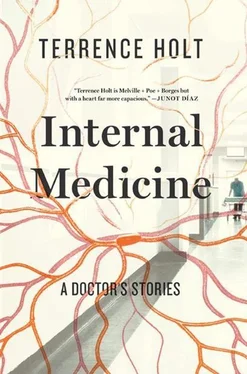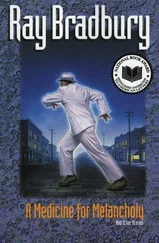There is more. Picking up, writing notes, a phone call or two. There is a family member in the hallway, sitting stricken on a bench beside a nurse or volunteer holding a hand. You need to speak to her, but before you do you have to find out the patient’s name. Or you don’t. And then you go back to whatever you were doing before the code went out over the PA.
WHAT I’M THINKING, USUALLY, as we trickle out at the end, is this: What a mess.
There is a great deal of mess in hospital medicine, literal and figurative, and the code bunches it all up into a dense mass that on some days seems to represent everything wrong with the world. The haste, the turmoil, the anonymity, the smell, the futility: all of it brought to bear on a single body, the body inert at the center of the mess, as if at the center of all wrong it remains somehow inviolate, beyond help or harm; as if to point a moral I would understand better if I only had time to stop and contemplate it. Which I don’t, not that day. We’re admitting and there are three patients, two on the floor and one down in the ER, waiting to be seen. There is no time to read the fine print on anything, least of all the mortal contract just executed on the anonymous woman lying back in that room. I can barely make out the large block letters at the top: Our Patients Die. And very often they do so in the middle of a scene with all the dignity of a food fight in a high school cafeteria. We can’t cure everybody, but I think most of us treasure as a small consolation that at least we can afford people some kind of dignity at the end, something quiet and solemn in which whatever meaning resides in all of this may be — if we watch and listen carefully — perceptible.
Which may be why one particular code persists in my memory, long after the event, as the perfect code.
DAVID GILLET WAS THE name I got from the medicine admitting officer. I wasn’t sure what to make of the MAO’s story, but I knew I didn’t like it.
The story was an eighty-two-year-old guy with a broken neck. He had apparently fallen in his bathroom that morning, cracking his first and second vertebrae. I had a vague memory from medical school that this wasn’t a good thing — the expression “hangman’s fracture” kept bobbing up from the well of facts I do not use — but I had a much more distinct impression that this was not a case for cardiology.
“And Ortho isn’t taking him because?” I said wearily.
“Because he’s got internal organs, dude.”
I sighed. “So why me?”
“Because they got an EKG.”
The MAO was clearly enjoying himself. I remembered he had recently been accepted to a cardiology fellowship. I braced myself for the punch line.
“And?”
“And there’s ectopy on it. Ectopy .” He then made a noise intended to suggest a ghost haunting something.
“Ectopy,” meaning literally “out of place,” refers to a heartbeat generated anywhere in the heart but the little knob in the upper right-hand corner where heartbeats are supposed to start. Such beats appear with an unusual shape and timing on the EKG. They can be caused by any number of things, from too much caffeine to fatigue to an impending heart attack, but in the absence of other warning signs ectopy is not something we generally get excited about. And it sounded to me as though a man with a broken neck had enough reasons for ectopy without sending him to the Cardiology service.
“So?” I said, trying not to sound indignant.
“So he’s also got a history. Angioplasty about ten years ago, no definite history of MI. You can’t really read his EKG because he’s got a left bundle, no old strips so I don’t know if it’s new.”
We were down to business.
“So I rule him out.”
“You rule him out. Ortho says they’ll follow with you.”
“Lovely. And once I rule him out?”
“Ortho says they’ll follow with you.”
I said something unpleasant.
The MAO understood. “Sucks, I know, but there you are.”
And there I was, down in the ER on a Sunday afternoon, turning over the stack of papers that David Gillet had generated over his six hours in the ED. There was a sheaf of EKGs covered with bizarre ectopic beats, through which occasionally emerged a stretch of normal sinus rhythm, enough to see that there was, indeed, a left bundle branch block, and not much else. The heart has several bundles, cables in its internal wiring. When some disease process disrupts a bundle, the result is an EKG too distorted to answer the question we usually ask it: Is this patient having a heart attack? Of course, the bundle itself is not a reassuring sign, and if new it merits an investigation, but plenty of people in their eighties have them and it’s pretty much a so-what. But the ectopy on today’s strips was impressive — if you didn’t know what you were looking at you might think he was suffering some catastrophic event. I read between the lines of the consult note the orthopedic surgeons had left, and it was clear they regarded David Gillet as a time bomb, and didn’t want him on their service.
Which I couldn’t help noting was exactly how I felt about having a patient with a broken neck on my service. But I didn’t get to make decisions like that. Instead I wadded the stack of papers back in their cubby and took a brief glance through the curtains of Bay 12. From my somewhat distorted perspective, most of what I saw of the patient was his feet, which were large, bare, and protruding from the lower end of his ER blankets in a way that suggested he would be tall if I could stand him up. At his side sat a small, iron-haired woman who at that moment was speaking to him, leaning close while she spoke. She wore a faint, affectionate smile on a face that looked otherwise tired. I watched her for a moment, her profile held precisely perpendicular to my line of sight as though posed. For a moment her face took on an almost luminous clarity, the single real object in the pallid blur of the ED, a study in patience, in care — and then it wavered, receding into a small tired woman with gray hair beside a gurney in Bay 12. The patient’s face was obscured by the pink plastic horse collar that immobilized his neck. I watched the woman for a minute. Her expression, the calm progress of their conversation, suggested that nothing too drastic was going on. I took a walk to the radiology reading room to get a look at the neck films.
There were many of these, too. They showed the vulture-neck silhouette all C-spine films share. There were several unusual views, including one that I decided must have been shot straight down the patient’s open mouth: it showed, framed by teeth palisaded with spiky metal, the pale ring of the first vertebra, the massive bone called the atlas, and clear (even to me) on both sides of it were two jagged dark lines angling in on the empty center where the spinal cord had failed to register on film. The break in the second vertebra was harder to make out, but I took the surgeons at their word: C1/2 fx. Will need immobilization pending installation of halo. Will follow w/you.
I WAS NOT IN the best of moods as I made my way back to the ER, grabbed a clipboard, and parted the curtains to Bay 12. I still managed an adequate smile as I introduced myself. “David Gillet?” I said tentatively.
The woman at his shoulder blinked up at me, wearing that same weary smile, brushing an iron-colored lock of hair from her face.
“It’s ‘ Zhee-ay ,’ ” she said, with an odd combination of self-deprecation and something else — perhaps it was warmth? — that made me like her. “It’s French,” she explained. Her smile widened, one of those dazzling white things older people sometimes possess (dentures, I believe), and she welcomed me into Bay 12, which I had been inside of more times than I cared to count, with a curious air of apology, as if concerned about the quality of her housekeeping. I was charmed. This was still relatively early in the day and I was capable of being charmed. I shook myself a little, straightened my back (her posture was perfect), trying to escape some of the lethargy that had been piling on me over the day.
Читать дальше












